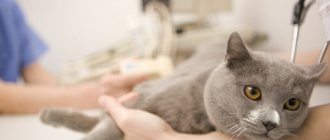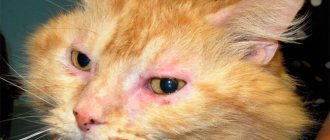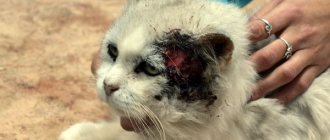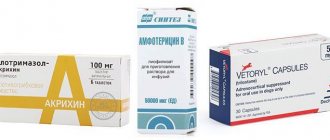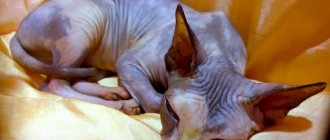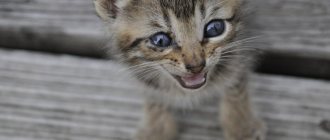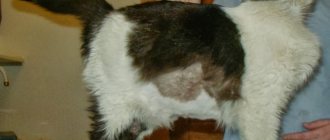Everyone knows that cats love to walk on their own. If an animal has the opportunity to go outside, then it will examine everything along the way. Usually cats have their own territory and someone else's. They protect their area. This can be the pre-house area or the entire land where the house with its yard and plantings stands. In addition to their area, cats explore neighboring buildings. This feature of the animal’s behavior leads to certain risks to its health. Namely, the cat can get hurt, and the resulting injury can cause the process of rotting. There is one peculiarity: it lies in the fact that the process of suppuration, or abscess, most often begins in cats. But its occurrence in cats or kittens is not 100% excluded.
Types of abscess and photos
Today, the most common types of abscesses that occur in animals are:
- Suppuration located inside the oral cavity.
- A combat abscess, in which wounds can be located on any part of the animal’s body.
- Abscess of the paraanal glands is suppuration of the glands that help animal feces move along the extreme segment of the digestive tract.
Let's look at the types of diseases listed above in the table below.
Table 1. Types of abscesses in cats
| View | Image | Characteristic |
| Dental abscess | Dental abscess or oral abscess | The occurrence of a dental abscess most often occurs in a situation in which you, that is, the owner of the animal, did not care about the condition of his oral cavity. As a result of the lack of regular cleanings and the build-up of plaque, periodontal disease forms, which gradually leads to the development of a serious infection, due to which the cat develops ulcers on the gums. This condition seriously impairs the quality of life, because your cat:
|
| "Combat" abscess | Battle abscess that has spread to the cat's cheek and neck | The name of this type of abscess refers us not so much to the location of the sore, but to the cause of its occurrence. So, the cause is usually fights with other cats or, for example, dogs, as a result of which your pet’s opponent injures him with his teeth. As you know, the oral cavity of every animal contains a huge number of bacteria. When a puncture wound from a bite occurs, these bacteria penetrate your cat's skin. Since the healing ability of the animal body manifests itself much faster than that of humans, the torn epithelium in them quickly heals in almost one hundred percent of cases, and the infection remaining after the bite is isolated under the skin. Provided that your cat's immunity is strong, she will be killed, otherwise suppuration will begin |
| Abscess of the paraanal glands | Anal gland abscess in a cat | The paraanal glands are located in the anus area of pets. The secretion they produce is designed to soften the pet’s feces and facilitate their rapid and effective exit. However, in some cases, the glands begin to produce excess secretion and become clogged. If in the norm of things the release of this substance should be carried out during the passage and pressure of feces, then with the presented pathology this does not happen. Due to excess and stagnation of secretion, the glands begin to become inflamed. The causes of this disease usually lie in:
|
Please note: no matter what type of abscess your cat is affected with, along with this disease he has a high risk of contracting feline AIDS.
Feline immunodeficiency (feline AIDS): symptoms
Among other things, as we mentioned above, the animal’s body will weaken so much that many other infections and diseases can freely develop inside your pet’s body. Unfortunately, it is very difficult to treat a whole “bouquet” of diseases, and often the work of veterinarians yields nothing, and the exhausted animal dies.
Diagnostic procedures
An abscess can appear in pets after sterilization or under the influence of other negative factors. When the first symptoms develop, you should contact a veterinarian who will help you properly treat the disease without causing complications. Before treatment, a comprehensive diagnosis is carried out to determine the source of the abscess, its type and severity. The cat needs to undergo the following diagnostic procedures:
- laboratory testing to determine the causative agent of the disease;
- antibiotic sensitivity test.
During differential diagnosis, the presence of a hematoma in the animal should be excluded.
No less important is differential diagnosis, which helps to distinguish an abscess in a cat from pathologies such as:
- cystic formation;
- benign or malignant tumor;
- granuloma;
- hematoma;
- lymphoextravasate.
Signs of an abscess (abscess, abscess) in cats
So that you can react in time and help your pet, you need to understand how the abscess that affects his body manifests itself.
How to identify an abscess in a cat?
Let's look at the main list of signs, if detected, you can identify an abscess and contact a veterinarian in time.
- The main and, perhaps, the most accurate sign in which you can clearly understand that you have an abscess is the detection of infiltration on your pet’s body. An infiltrate is a tubercle, inside of which there is clearly some kind of liquid, which is soft to the touch. The skin at the site of infiltration formation may change color, or may retain its original shade;
- The second sign of an abscess in an animal is pain. It can be localized:
- At the site of immediate suppuration.
- Near the infected area.
In other words, your cat will react violently and dissatisfiedly not only to pressure and touch in the area of the tubercle, but also on the surface of the body adjacent to the lesion. Even if you try to pet him, the sensation will be unpleasant, and the cat will show it.
- disruption of the normal functioning of the part affected by the abscess is another sign. We mean that due to pain, the animal will try not to touch the location of the infiltrate. So, for example, it may manifest itself as follows:
- If the suppuration is located in the oral cavity, the animal may completely refuse food and will only drink water.
- Provided that the abscess affects the paw, the cat will stop stepping on it, or will walk with a limp.
- The fourth sign of abscess formation is baldness of the place in which it is located. Provided that your cat has fur (there are also hairless cats), you will notice the abscess even from afar, since in the place where it will be located you will find:
- Bald spot.
- Puncture wound.
- Scabs.
Baldness in the area of the abscess
- Another unambiguous sign of the presence of an abscess in your pet is the discharge of pus with blood from the wound, in the place where your beloved cat was bitten by the enemy;
- provided that the paraanal gland is affected by the abscess, you will see a large, most likely red, lump next to the animal’s anus;
- a terribly unpleasant odor will emanate from the site of suppuration, characteristic of rotting wounds;
- the presence of such a serious inflammatory process can also affect the behavior of the animal and its general well-being. So, in almost one hundred percent of cases the cat will:
- Lethargic.
- Experience a fever.
- Refuse food.
With an abscess, the animal becomes inactive
As you can see, there are quite a few symptoms of an abscess. Only the most inattentive owner will not notice such a serious disease in his animal, because it causes discomfort and pain to the cat. Remember that animals are creatures with a nervous system. They feel pain just like humans, and are capable of experiencing negative emotions just like us.
You cannot delay treatment, because your pet feels pain, both on a mental and physical level
Signs of suppuration development
In cats, purulent abscess is a common occurrence. It is important for the pet owner to know all the symptoms of the pathology in order to respond promptly and correctly to its appearance.
An abscess goes through 5 stages of development:
- Redness of a small area of skin . The pathological process can only be identified with a detailed examination. The animal does not experience any discomfort when the disease occurs.
- Edema . As the infection spreads, a cavity forms under the skin, which gradually fills with pus and swells.
. The purulent capsule is completely filled with contents, increases in size, and becomes convex.
Fluctuation- Baldness . Hair begins to fall out on the affected areas of the skin and they become completely bare. During this period, the owner can easily determine the presence of pathology.
- Tissue necrosis . Ideally, if the animal has a strong immune system, if there is severe suppuration, the purulent capsule should rupture, and the contents will come out to the surface of the skin. In weakened animals, the inflammatory process continues and healthy cells become infected.
Causes of abscess in cats
As we said earlier, the reasons for the development of an abscess are:
- damage;
- infection.
Infected with this pathology can be:
- epithelium;
- paraanal glands;
- oral cavity.
Most often, a cat’s abscess is a skin abscess, that is, a combat abscess, which developed as a result of receiving a bite in a fight with an enemy. As for harmful bacteria, which become infectious agents in each of the described cases, the following are most often found in pus:
- streptococcus;
- staphylococcus, etc.
It is during the reproduction of harmful organisms included in the class of pyogenic that a liquid substance is formed in the wound
However, it is not always necessary to damage the skin for the birth of an abscess. The infection will thrive in those tissues of the cat's body that have cavities, for example, in the gums surrounding the animal's teeth. Such an abscess forms when an infection enters your pet’s body and he is unable to fight it off on his own.
Prevention of the development of purulent formations
Cat owners should try to prevent any disease in their pets. Preventive measures are the best remedy for the development of an abscess.
Necessary activities:
- castration;
- limiting walks on the street and contact with yard animals;
- vaccination according to schedule;
examination and sanitation of the oral cavity, brushing teeth twice a week;- exclusion of small bones and rough foods from the diet;
- regular inspection, identification of skin damage, their timely disinfection and treatment;
- sterilization of instruments during medical procedures at home;
- treatment for fleas, ticks, lice;
- maintaining sanitation and hygiene.
As soon as a kitten gets into the house, it needs to create all the necessary conditions for proper development, provide age-appropriate food, and provide timely veterinary care.
Complications caused by an abscess
The development of an abscess, as we have already mentioned, has a direct impact not only on the occurrence of pain and the appearance of pus in the infected area, but also worsens the overall well-being of the pet. Among other things, this pathology is also capable of creating favorable conditions for the occurrence of other diseases and the progression of infection.
What complications can occur with an abscess in cats?
So, provided that you did not make a decision on timely treatment of the cat’s abscess or discovered the abscess too late, these consequences and complications can complicate the life of your pet, and yours along with it.
Thus, abscesses are characterized by pain. A constant feeling of pain seriously affects the animal’s psyche, causing:
- groundless aggression;
- nervous tension;
- sudden weight loss;
- attempts to tear objects;
- going to the toilet in a variety of places, for example, on the sofa or the owner’s bed.
Groundless aggression
Another dangerous complication can occur like this: the infection from the abscess will spread into the tissue and infect such important elements of the cat’s body as:
- ears;
- joints, etc.
This can also happen when the wound is located on the very surface of the skin, or is far from the ears
Cats infected with a combat abscess are most susceptible to such terrible diseases as feline AIDS, etc.
Infection from an oral abscess can spread to the brain. In this case, the animal will begin to behave inappropriately and, most likely, will die in agony.
As you can see, curing your pet quickly is your main task. Adopting a cat means not only having a furry friend that you can hug and pet, but also acquiring a huge responsibility towards him. This responsibility includes feeding a quality diet, constant attention, regular bathing and grooming, and timely and regular veterinary visits.
If you are not ready to spend time and money on maintaining and treating a cat, it is better not to adopt it in the first place.
You can also think that the larger the abscess, the more pus and blood will be released from it, which will stain the furniture, floors, and walls that the animal touches. Take pity on him and yourself and immediately run to the doctor.
Why does it appear?
What are the causes? As a rule, this happens with minor injuries or scratches. In fairly rare cases, an abscess appears in the mouth. This is a consequence of a cat eating (especially in the trash) small fish bones, which dig into the mucous membrane and introduce infection into the tissue. For cats, this is a standard consequence of “gang wars,” especially in March.
In the most “honored veterans”, ulcers often appear on the cheek, since this is where they often hit with claws, and the frequency of bites in this area is quite high. By the way, a cat bite is considered one of the dirtiest injuries; it takes a long time to heal and very often festers. So every cat has a purulent abscess, more than once or twice in its entire life. Experts can often recall something completely “exotic”, like an attack by a crow: its beak can cause even worse consequences!
In principle, the appearance of an abscess is also possible if the cat receives some small wounds, but this is unlikely, since in this case there is free access of air to the damaged area, which the pyogenic microflora does not “like” very much. However, we forgot about one more reason. It happens that an abscess develops after an injection.
If an abscess has developed on the paw, then most likely the cat simply stepped on a thorn or thorn. Often, it’s not even a matter of the microflora brought into the wound, but rather the pieces of wood or earth remaining in the wound canal. In general, the reasons for the appearance of such sores are quite simple and obvious.
READ Fungus in cats - symptoms, treatment, medications, causes
Risk factors
Many cat owners live side by side with their pets for many years, but never observe the development of an abscess in them, while others, on the contrary, are constantly forced to treat this infection. Let's figure out what risk factors contribute to the occurrence of the desired disease in a particular cat.
The very first factor due to which your pet can be classified as a risk group is the free range of the cat. At their core, cats are domestic animals, not suited for life on the street, no matter what anyone says. Provided that you let your cat, especially an uncastrated one, out for a walk unattended, that is, not on a harness or leash, without your presence, be prepared for the fact that sooner or later they will run into an aggressive brother or an angry dog who in battle they will certainly inflict wounds on your pet. These same wounds will then become the reason for the formation of suppuration.
The life of free-ranging cats always ends badly, even if you think they need walks. Including many domestic cats walking on their own die from abscesses or lose vital organs
The best prevention aimed at reducing harm from this risk factor is depriving the animal of going outside. If you think that a cat should definitely go for a walk and this is done for the sake of its health, go to the end in the matter of its safety: go for a walk with the animal yourself, having first put a harness and leash on it.
The second risk factor, which has a certain impact on both cats walking on the street and those living at home with other animals, is being male. As you know, cats are more pugnacious than cats simply by nature, since they defend their territory at the level of instincts. Even in an apartment, if the cat thinks that someone is encroaching on his bowl, bed, or tray, a fight can break out, which will result in bites and the formation of infiltrates.
Cats show their character more aggressively
The third risk factor is temporary. So, when you bring a new animal into your home (whether a cat or a cat), be prepared for the fact that, regardless of gender, your pets will fight at first. In this way, both will demonstrate their strength before getting along peacefully and realizing that they share the territory of your home, whether they like it or not. However, it is best to stop these fights so as not to lead to illness. For this you can use:
- spray bottle with cold water;
- stern voice;
- spanking (namely spanking, not beating) with a rolled up newspaper.
The young age of the pet (up to about 7 years) is another risk factor. Young animals can fight even when they love each other. In fact, the fight in this case will be a game, but the bites will remain real. To protect mustachioed pets from getting hurt, try to redirect such games into a more peaceful direction, and play with them at the same time yourself, for example, using:
- medium sized balls;
- laces with a toy at the end;
- delicious treats, etc.
Even during harmless games, animals can injure each other.
Cats that have previously had an abscess may get it again, provided that the last wound, which apparently healed, did not heal completely, or their body did not, as you thought, cope with the infection on its own. These pets have a particularly high risk of spreading the infection.
Cats whose owners do not take care of their oral health are also at risk. Tartar must be cleaned if you want the animal to live long and be able to feed on its own. This service is provided in veterinary clinics. Believe me, this procedure is necessary for your cat, and for those who argue that street cats, for example, do not need cleaning, because nature intended it that way, answer that these animals are the fruit of selection work, and were not originally intended by nature. This means that all these speculations do not apply to them.
Tartar in a cat
Inflammation of the paraanal glands in a cat should be expected by those owners who do not monitor the animal’s motor activity and feed it the wrong food. In rare cases, the development of such an unpleasant disease can occur due to breed predisposition.
Causes and symptoms
Healthy animals also have discharge from their visual organs. As a rule, these are ordinary tears of a grayish, sometimes reddish hue. The reasons why they appear are different and there are quite a lot of them. If a cat's eyes are watery and purulent, this is not a cause for concern, especially if the discharge is rare and isolated. It is also worth considering the characteristics of the discharge. If simple tearing is normal, then the appearance of thick green or yellow pus is already an alarming sign.
First, let's figure out why a cat's eyes fester - what is the reason? After all, without understanding the cause, it is more troublesome to understand and cure the disease. Typically, these clear, watery discharges appear as a result of allergic reactions or mechanical damage. They may have a grayish or reddish tint.
Greenish or yellowish, thick, purulent discharge from a cat's eyes is considered a symptom of a bacterial or fungal infection. The disease cannot go away on its own, so these signs cannot be ignored.
Ocular and systemic diseases may be accompanied by purulent discharge from the cat's eyes. Eye diseases include:
- diseases of the cornea, eyelids;
- eye injuries;
- conjunctivitis.
Systemic diseases include chronic viral infections, panleukopenia or plague.
An attentive owner will quickly notice that the cat’s eyes are constantly festering, but in addition, the owner should be wary if the sick animal has additional symptoms indicating a problem:
- the animal looks worried, rubs its eye with its paw, refuses to eat;
- hides in dark places, body temperature may increase;
- the fur around the eye is felted and has a brown tint;
- the organ of vision is blurred and reddened.
You don't need a veterinarian's degree to understand that something is wrong with the animal. By the way, if you notice that your cat’s eyes are red and festering, redness does not have to be taken as a symptom of any illness. Most likely, this is a consequence of irritation of the eye with ichor, or the pet itself rubbed it with its paw, trying to get rid of the pain and itching that does not give rest.
When the first symptoms appear, the cat should be taken to the veterinarian in order to be correctly diagnosed and tested. To exclude conjunctivitis, the veterinarian performs a microanalysis of the cat’s eye mucosa and prescribes a comprehensive treatment. May prescribe antibiotic treatment - general therapy. For local therapy, ointments and eye drops are prescribed.
Bruise or injury to the eyelids is another important factor in the appearance of pus from the eyes. In this case, inflammatory processes are transmitted to the eyeball. You can get injured for various reasons: a fight, carelessness during the game and much more.
A cat can get blepharitis, which occurs due to traumatic, chemical, and thermal effects on the eyelids. The damaged area is an open door for germs, viruses, and pathogenic fungi that infect the eye.
Keratitis (inflammation of the cornea) is another disease that causes the cat’s eyes to fester.
Allergens – dust, perfume, pollen, medications.
There are many other reasons for the appearance of purulent discharge:
- dream;
- bad food;
- household chemicals;
- structural feature of the muzzle.
Diagnosis of an abscess
One of the main tasks of cat owners is timely diagnosis of the condition of their pets, detection of various pathologies, such as an abscess. Remember, animals cannot speak, so they will not be able to explain to you what hurts them and how much.
All responsibility for the cat's health lies with you.
We have already said what signs an abscess can be identified by, but let’s once again briefly refresh our memory about what we were talking about. So, an abscess has the following characteristics:
- looks like a dense tubercle;
- soft to the touch;
- hot at the site of infection;
- yellow pus mixed with blood oozes from it;
- the cat demonstrates that it is in pain when you touch the infected area or area near it;
- an unpleasant odor emanates from the wound.
Unfortunately, hair at the site of suppuration does not always fall out, so the first thing cat owners should pay attention to is a change in its general condition, namely:
- lethargy;
- fever;
- lack of appetite;
- even aggression is possible;
- inappropriate behavior, for example, going to the toilet in the wrong place.
Lack of appetite
Provided that the condition of your animal has really changed, you should carefully examine those places where cats prefer to attack the enemy, namely:
- paws;
- tail;
- head;
- neck.
These are the points that animals consider weak, and this is where their relatives attack them. However, if your animal was bitten by a small dog or a particularly irritated cat, the abscess may be located on any other part of the body.
You should also monitor your cat's response to pain. Depending on the location of the abscess, she will try to protect the affected part of the body, that is:
- do not step on the sore paw;
- do not eat if your mouth is infected;
- do not allow herself to be stroked for fear that you will touch a place that is infected, because the pain of an abscess is very difficult to bear.
To save itself from pain, a cat may not change position all day and even bite you to keep you from coming closer.
Non-dangerous causes of the problem
Non-dangerous reasons include physiological ones, that is, those associated with the characteristics of the body. Most often, mucous fluid appears during estrus, pregnancy and after childbirth.
Pregnancy and childbirth
By the 3rd week after mating, the cat begins to have a clear discharge with thick mucus. They are difficult to notice because they are excreted in the urine. The secreted mucus is excess plug that clogs the cervix. During pregnancy, it protects the fetus from infections.
Closer to 6 weeks, excess amniotic fluid comes out of the loop. It has a transparent or yellowish tint.
At 9 weeks the plug is rejected. Having noticed the appearance of a yellowish or greenish clot, you can begin preparing for childbirth. With the onset of contractions, the cat begins to have bloody discharge.
After the kittens are born, mucus may be released from the loop for another 3 weeks. No need to worry about this. Your cat's reddish discharge will gradually turn brown and disappear. Greenish inclusions are also acceptable these days.
Estrus
Unlike dogs, cats should not bleed during heat. The mucus emerging from the loop should be transparent and uniform in consistency. The presence of an unpleasant odor is unacceptable.
The duration of estrus is from 3 to 7 days. At this time, the pet becomes very excited and affectionate. She sleeps poorly at night, constantly meows and arches her back, moving her tail to the side when you press on her sacrum. The onset of estrus can only be noticed by behavioral changes, as the animal is constantly licking itself.
Going to the vet
If you suspect an abscess, you should not try to squeeze the pus or cauterize the wound with alcohol (both are very painful, have mercy on your animal), but should quickly pull yourself together and seek help from a reputable veterinarian.
An experienced doctor, even if the abscess is hidden behind thick hair, will examine the hairline and find dull areas on it, behind which, most likely, an abscess will be found.
Then careful palpation will be performed to detect the infiltrate. In this case, you will most likely have to hold the animal, otherwise it will scratch the doctor.
If a tubercle is detected, the fur at the site of suppuration is shaved off. Often traces of a wound are found on bare skin, which was the reason for the development of suppuration. In some cases, the wool is also clipped in other places, and new ones are discovered:
- wounds;
- abscesses.
In some cases, they are even applied by different teeth.
To determine the specific disease, your veterinarian will need to examine your friend.
Most often, experienced veterinarians diagnose abscesses solely through external examination and light palpation, however, in some situations it is necessary to:
- bacterial culture analysis;
- microscopic analysis of the substrate flowing from the wound.
Provided that you are one of those owners who monitor their animal, most likely you will be able to detect the disease in the early stages and go to see an animal doctor. Unfortunately, in this case, the doctor will not be able to diagnose you immediately; he will need to:
- run a couple of tests;
- carry out a medical examination.
Please note that the cost of such tests is extremely low, and waiting for a painful abscess to form in an animal in order to save money is not only cruel, but also extremely useless.
How to treat?
Treatment of purulent eyes is primarily aimed at identifying and eliminating the cause that irritates the mucous membrane. The effectiveness of treatment procedures depends on how correctly the diagnosis is made. If it is a bruise, the damaged area is cleaned with hydrogen peroxide. In case of blepharitis, they deal with the cause that caused it. Conjunctivitis occurs - it’s time to see a veterinarian for comprehensive treatment.
How to treat a cat whose eyes are festering? Even before meeting with the doctor, the cat must be given first aid. If there is purulent thick discharge, then you need to rinse your eyes. You cannot do this without an assistant, since it is very difficult to complete this procedure alone.
Eye wash
This procedure is carried out using chamomile decoction, boric acid solution and furatsilin. 2 tsp boric acid should be dissolved in 0.5 tbsp. water, the furatsilin solution should be 0.02%. You only need to rinse with a warm solution, not a hot one. The cotton wool needs to be twisted into a tight rope, dipped into the solution and squeezed out the liquid onto the pet’s eyeball. It is recommended to carry out the procedure until the eyes become clear.
Tampons must be changed during operation; a tampon cannot be used more than once. You should not use cotton swabs, as they do not absorb liquid. To avoid injuring the cat's eyeball, do not touch it with a dry swab.
The eyes are cleared of purulent discharge; it is now recommended to apply tetracycline eye ointment (1%) under the eyelids. It is necessary to pull back the lower eyelid and coat its internal cavity with ointment with a special spatula. Then you need to close the cat's eye and massage it lightly. This will ensure the ointment is evenly distributed over the eye. It is recommended to warm the tube of ointment in your hands, so the applied product will be better distributed over the eyeball.
If the cat is nervous and resists, the ointment should not be applied, otherwise it may cause injury to the eye.
Treatment of abscess (abscess, abscess) in cats
Of course, today many owners of cats with an abscess have turned to veterinarians, so today there are the most effective schemes for eliminating the desired pathology. Exactly how your pet will be treated will depend on what stage of development the disease is in when presented.
How are abscesses treated in cats?
First stage
In the early stages, treatment with the following drugs is used:
- penicillin antibiotics to eliminate harmful microorganisms;
- novocaine to eliminate pain;
- streptocides to fight infection.
All of the above drugs are taken orally, while external treatment is also practiced, namely:
- lightening with a Sollux infrared lamp to resolve inflammation and relieve pain;
- ultraviolet light to dry the wound;
- heating pad and warming compresses to eliminate pain.
All of the above procedures allow you to eliminate the abscess quickly and with minimal losses to the cat’s health.
Second stage (formed abscess)
Treatment of an abscess that has already formed is carried out through invasive intervention, since the main task of doctors at this stage is to remove the purulent substrate from the wound. For this:
- the animal's fur is shaved off at the site of the inflamed area and around it;
- the animal's skin is disinfected;
- the animal is put into a state of anesthesia;
- a long incision is made at the site of inflammation;
- the wound is opened and all accumulated pus is removed.
it is very important to leave the wound open and dry, because the pus that is not completely removed will then lead to the re-formation of an abscess.
A cat who has received this treatment is prescribed:
- washing the wound with antiseptics (not alcohol, otherwise the tissue will be burned);
- taking antibiotics.
Treatment of the wound
Fortunately, due to the ability of the animal body to recover very quickly, which we previously mentioned, after cleaning the wound, the animal recovers almost within a few days.
Third stage (advanced abscess)
Provided that for some reason you have started the disease, and the abscess has spread deeply and grown to a substantial size, doctors, just as in the second stage, will open the wound and clean it of pus. However, in this case, you will have to sew it up, not just like that, but leaving the latex tubes sewn in so that the cleaned cavity can be drained from the newly formed pus.
Drainage tube
Vishnevsky ointment will need to be applied to the stitched wound, and after some time the wound will be cleansed through sewn-in tubes by injecting antiseptic drugs into them.
It also happens that due to the presence of an abscess in an animal, a necrotic process has begun in the tissues located next to it. In this case, they will need to be removed and processed:
- hydrogen peroxide;
- potassium permanganate;
- hypertonic solution.
Then the location of the former abscess should be sprinkled with antiseptic powders, and drainage with a hypertonic solution should be installed.
Treatment
After detecting a pathological process in a pet, you must immediately contact a veterinary clinic.
The sooner you start treating an abscess, the fewer negative consequences for the animal’s health will arise later.
Medicines
In the first stages of infection, pharmaceutical or veterinary drugs are used.
Antibacterial and anti-inflammatory agents are used. For these purposes, broad-spectrum antibiotics of the penicillin series are recommended: Tetracycline, Penicillin, Sinulox. The duration of therapy is from 7 to 14 days.
Surgical intervention
More often, an abscess requires opening in a hospital setting.
The place of suppuration is cleaned of hair and treated with antiseptics. Painkillers are administered, and the abscess is opened with a sterile scalpel. The pus from under the skin is cleaned out and drainage is installed.
After 3 days, the drainage tube is removed, anti-inflammatory ointments (Vishnevsky, Tetracycline) are placed in the wound, and a sterile bandage is applied. It is changed daily, tissue treatment is carried out twice a day.
To exclude the development of re-infection, broad-spectrum antibiotics are prescribed.
Treatment at home
Squeezing out ulcers on an animal’s body yourself is strictly prohibited. Without knowing the technology of tissue cleansing, you can direct the flow of pus under the skin or reinfect the infection.
There is a high risk of blood poisoning, which leads to irreversible consequences.
Prognosis without treatment
If the pet is not given medical care, this will lead to tissue necrosis, infection of healthy cells, and infection in an open wound. As pus spreads under the skin, the outcome can be fatal.
How to independently help an animal in the initial stages of the disease?
Provided that you have discovered a developing abscess in your pet, but cannot take him to the veterinarian in the next few days, you can help him, provided that you have at home, for example:
- healing mineral mud;
- veterinary or human ointment "Levomekol" or other antimicrobial agents, etc.
So, at the initial stage of suppuration, they heal well if they are treated with antibiotic ointments in a timely manner. “Levomekol” is the most affordable of them all; in a veterinary store, a fairly large amount of the product can be bought for about two hundred rubles.
In addition, mineral mud of natural origin will perfectly dry and eliminate pus. When heated, apply it to the animal’s abscess, and it will heal, if, of course, it has not yet begun to progress and go deeper into the tissue. The mud needs to be heated to approximately 42-45 °C.
Under no circumstances should you open an abscess yourself; entrust this work to a veterinarian.
However, even if the abscess has progressed, and there is still no opportunity to see a doctor due to objective reasons, try to give your patient antibiotics from one of the following groups:
- penicillin;
- cephalosporin;
- clindamycin.
In addition, be sure to do the following:
- give the animal an anesthetic (provided that the drug is calculated according to the instructions, based on the pet’s weight);
- Use an Elizabethan cone collar or other homemade protection to prevent the animal from licking and biting itself.
Until the abscess matures, warm it with heating pads or warming compresses. However, keep in mind that if the animal has a fever and you feel its temperature is elevated, you should not use them, as this will only worsen its condition.
After the wound has been cleared of pus by the doctor, the responsibility for continuing treatment will fall on you. It is assumed that you will have to:
- wash the wound;
- change bandages.
Do your best and your pet will remain healthy, no matter what stage the abscess is at.
Unfortunately, in the later stages, this disease is difficult to cure on your own. In addition, if we are talking about the occurrence of this pathology in the anal glands or in the mouth, it is impossible to do it yourself.
Let's sum it up
An abscess in a cat is an unpleasant disease characterized by the occurrence of suppuration:
- under the skin;
- in the gums;
- in the animal's anal glands.
Curing this disease can be difficult, especially if it is complicated by other pathologies, so the best solution for you is to isolate your pet from the street, and therefore from other aggressive animals. If you are still a fan of street walking, and are not at all afraid for the health of your pet, at least castrate/sterilize him. This will seriously reduce the desire to enter into conflict and fight for territory with other cats.
Take care of your animal, because you have taken responsibility over it
If fights occur between the old and new residents of your apartment, gradually introduce the pets to each other, offering them common leisure time in the form of sharing food and playing with you.
We would also like to draw your attention to the fact that an abscess in a cat can also develop in organs and other internal segments of the body. In such a situation, you are unlikely to be able to diagnose it yourself; you must promptly contact a veterinarian for a correct diagnosis and timely treatment of the disease.
Why does a boil occur?
A furuncle in a cat is a focal inflammation of the hair follicle and sebaceous gland, it is purulent and necrotic in nature, caused by staphylococcus bacteria (white or golden), see photo below. Simply put, the hair “bag” becomes inflamed, into which pathogenic bacteria and tissues around it enter. The process takes place under the skin, the affected tissues die (necrosis) and turn into pus, which is located in a kind of “vessel” that restrains the boundaries of inflammation. On the surface of a fully mature boil, you can see (sometimes more than one) gray-green dot - a rod.
The disease is not “universal”, but there are a number of breeds prone to the formation of boils. Most often, lesions appear on the chin - the cat scratches its face with its claws and causes an infection. Veterinarians identify a number of reasons that can trigger the occurrence of boils:
- Violation of conditions of detention, care, nutrition - lead to a decrease in the body's immune defense.
- Hypothermia, frostbite or skin burns, sudden temperature changes.
- Avitaminosis.
- Concurrent infectious diseases.
- Metabolic disorder or hormonal imbalance (estrus, false pregnancy, disease of the thyroid or adrenal glands).
- Chronic fatigue, anemia.
Important! Improper treatment of boils leads to relapses, but the affected area may become larger.


